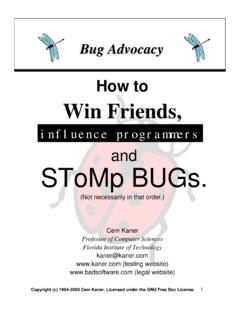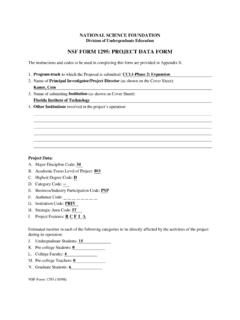Transcription of The Problem of Reverse Engineering - Cem Kaner
1 The Problem of Reverse EngineeringA common criticism of software publishers is that their EULAs prohibit reverseengineering, decompilation, and disassembly of their software. Softwarepublishers typically restrict these activities because they risk exposing, and hencelosing, to the public domain, the publisher's crown jewel-the secrets contained inthe software's source code. Most purchasers of off-the-shelf software, however,care little, if at all, about the right to Reverse engineer, and they certainly are notinterested in paying more money to acquire this right. The entities that are mostinterested in acquiring this right are competitors of the software developer.
2 Acompetitor should not be permitted to acquire the right to examine a company'strade secrets for the low price that the typical end user pays for the software. (CK-- Footnotes omitted. Also, a EULA is an end user license agreement, typicallytypically shrink-wrapped and presented to the customer after the sale.)--- Robert W. Gomulkiewicz (a senior corporate attorney at Microsoft) and MaryL. Williamson (1996)Many people misunderstand the nature of Reverse Engineering . Those misunderstandings shape corporatepolicies and legislation. As I've spoken to working software developers (especially and including testers)about Article 2B, I've been surprised to discover that we are as likely to misunderstand the breadth andimportance of Reverse Engineering as the lawyers.
3 (Article 2B is a 273-page proposed revision to the UniformCommercial Code that will govern all software-related contracts. For more information, see my website, , or my new book, Bad Software, which has a detailed appendix on 2B).Originally, I presented material on Reverse Engineering at a conference on Article 2B for lawyers at UCBerkeley. That led to additional talks and to a paper for lawyers ( Kaner , 1998). This paper is not about thelegal issues of Reverse Engineering . And, though I mention Article 2B (as the key current effort to ban reverseengineering), this paper is not about Article 2B. The Reverse Engineering debate will go on even if we kill , I have four objectives with this paper.
4 First, to make you aware of a debate whose resolution will affect your work (you probably doreverse Engineering quite often, and you might not like it if that gets banned). Second, to suggest some ways that you can articulate your concerns. (Your company might be oneof the ones pushing for a ban on Reverse Engineering . Maybe you should explain what this wouldcost them if they succeed.) Third, to appeal to you for examples. I wrote this paper out of my own personal 're good examples, but there are better ones. A longer collection of good examples might carrya lot of influence. And finally, to solicit criticism from you. I'm going to make these arguments again and again andagain and again.
5 If there are holes or unfairnesses, I'd like to know about them. For that reason,even though I have adapted this paper from the one that I wrote for lawyers (cutting out legalarguments), I've left my descriptions of Engineering issues largely ago, I worked in my parents' clothing business. We were mainly a retailer, but we also designedmerchandise and had it custom manufactured. We used to buy samples from other vendors (and from ourown suppliers) and take them apart to see how they were made. We did this to understand the quality of theproducts we were selling and the quality our competitors were selling. We did it to understand what types ofproblems our customers might have with a particular garment.
6 We did it for training, to teach selectedmembers of the staff how certain types of garments were made. And of course, we did it to understand howto knock off an improved version of a competitor's product. This was all legal. It's how many things areimproved over time. But what we were doing was Reverse a new machine comes to market, competing manufacturers will buy one and take it apart to see how itwas built and what it does. This is Reverse Engineering . It is absolutely legal. It is a normal part of innovation,one of the foundations of continuous quality improvement within an are inventions built into many types of products. When you take the product apart, you might come tounderstand the invention.
7 But the invention can be patented. If it is original, it can be fully protected underthe law, whether the competition understands it or not. And many aspects of the design of the product can becopyrighted or trademarked, so if they are original, they can be protected software publishers have decided that their inventions are special (more special than everyone else'sinventions, apparently) and that they should be able to prevent people from Reverse Engineering theirproducts. As Gomulkiewicz and Williamson said, it is common to see clauses in software licenses that barthe customer from Reverse Engineering the software. Such clauses have been enforced in negotiated, non-mass-market licenses, but they have not been enforced in a software product that was sold (or "licensed") inthe mass-market (see Sega Enterprises Ltd.)
8 V. Accolade, Inc., 1992).The result has been an ongoing debate over Reverse Engineering of software. One current forum for thedebate is in the discussions of the proposed Article 2B of the Uniform Commercial Code, which will letpublishers ban Reverse Engineering via "use restrictions" in the "licenses" that come with software forum involves proposed changes to the Copyright though some publishers and some manufacturers want to block Reverse Engineering (Apple and IBMhave taken influential positions in this direction), much of the software community disagrees. For example,the American Committee for Interoperable Systems (which includes Sun Micro, Amdahl, AMD, 3 Com andothers) forcefully criticized Article 2B on the basis that it makes it much easier for software publishers to banreverse Engineering (Choy, 1998).
9 So have associations representing software developers, such as theInstitute for Electrical and Electronic Engineers (Reinert, 1998) and the Association for ComputingMachinery (Gelman, 1998).What Is Reverse EngineeringAs I understand the term, " Reverse Engineering " encompasses any activity that is done to determine how aproduct works, to learn the ideas and technology that were used in developing that Engineering can be done at many levels. At one extreme, you can study a product through strictly "black box" methods, feeding the program data(inputs) and monitoring its outputs. ( Black box analysis refers to Reverse Engineering techniques that donot involve copying or modifying the software.)
10 Thomas Smedinghoff (1993, p. 85). A software licensecould specifically ban the use of a program in ways that are intended to reveal the underlying structure ortechnology of the program. Such a ban would work under Article 2B. At the other extreme, you can disassemble or decompile the program. In this case, you use a tool (such asa disassembler) to translate machine-readable 1's and 0's into Assembly Language, a low-level buthuman-readable programming language. Most programs are actually written in a high-level language(such as C or BASIC or COBOL). For example, you can issue a command,PRINT 5A translation of this simple command into Assembly Language might require several hundred (or more)lines of Assembler you disassemble a program, you get thousands of lines of code, in a language that was not used bythe original programmer, that lacks the comments, variable names, formatting and other signals used bythe programmer to explain the meaning of the program.






